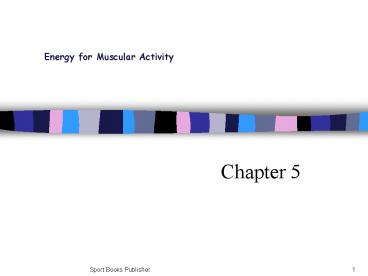Energy For Muscular Activity - PowerPoint PPT Presentation
1 / 13
Title:
Energy For Muscular Activity
Description:
Energy for Muscular Activity Chapter 5 Learning Objectives: To develop an awareness of the basic chemical process that the body uses to produce energy in the muscles ... – PowerPoint PPT presentation
Number of Views:118
Avg rating:3.0/5.0
Title: Energy For Muscular Activity
1
Energy for Muscular Activity
- Chapter 5
2
Learning Objectives
- To develop an awareness of the basic chemical
process that the body uses to produce energy in
the muscles - To develop an understanding of the bodys three
main energy systems - To introduce the effect of training and exercise
on the energy systems
3
The Chemistry of Energy Production
- Energy in the human body is derived from the
breakdown of complex nutrients like
carbohydrates, fats, and proteins. - The end result of this breakdown is production of
the adenosine triphosphate (ATP) molecule. - ATP provides energy necessary for body functions
4
ATP Cycle Overview
- a) ATP breakdown
- b) Phosphorylation
- c) ATP resynthesis
5
- a) ATP breakdown (ATP turnover)
- 1. Hydrolysis of the unstable phosphate groups of
- ATP molecule by H2O
- 3. Energy is released (38-42 kJ, or 9-10kcal/ mol
ATP)
6
- b) Phosphorylation
Energy for muscle contraction
1. Energy released by ATP turnover can be used
by body when a free P group is transferred
to another molecule (phosphorylation)
7
- c) ATP resynthesis
- Initial stores of ATP in the muscles are used up
- very quickly and ATP must be regenerated
2. ATP is formed by recombination of ADP and P
3. Regeneration of ATP requires energy (from
breakdown of food molecules)
8
The Energy Systems
9
The Roles of the Three Energy Systems in
Competitive Sport
10
1. The High Energy Phosphate System
11
The High Energy Phosphate System Overview
12
High Energy Phosphate System
ADP Pi ? ATP
13
Training the High Energy Phosphate System
- a) Interval training
- - 20 increase in CP (creatine phosphate)
stores - - no change in ATP stores
- - increase in ATPase function (ATP -gt ADPP)
- - increase in CPK (creatine phosphokinase)
function (CPK breaks down CP molecule and
allows ATP resynthesis) - b) Sprint training
- - increase in CP stores up to 40
- - 100 increase in resting ATP stores

